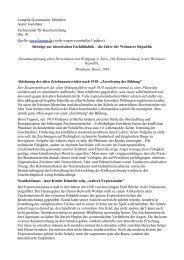Research in Visual Arts Education - The National Society for ...
Research in Visual Arts Education - The National Society for ...
Research in Visual Arts Education - The National Society for ...
Create successful ePaper yourself
Turn your PDF publications into a flip-book with our unique Google optimized e-Paper software.
BETWEEN VISUAL ARTS AND VISUAL CULTURE<br />
and Helene Illeris, decided to start from scratch through the controversial<br />
establishment of the new research unit <strong>Visual</strong> Culture <strong>in</strong> <strong>Education</strong> at the<br />
Department of <strong>Education</strong>al Anthropology.<br />
This choice changed the primary focus of Danish visual arts research<br />
from curriculum studies and children’s pictorial production to an educational<br />
anthropological approach focused on the concept of culture and the<br />
cultural significance of visuality <strong>in</strong> education. As a consequence, the <strong>in</strong>itial<br />
research of the unit was not about the development of the school subject,<br />
but rather about how the concept of visual culture can enrich education<br />
across traditional divisions based on subjects and levels.<br />
In 2003 and 2004 the unit published two special issues of educational<br />
journals dedicated to visual culture, one <strong>in</strong> Danish directed at teachers,<br />
and one <strong>in</strong> English directed at the Nordic educational research community<br />
(Buhl, Flensborg and Illeris 2003, 2004). In addition, an <strong>in</strong>troduction to the<br />
research themes of the unit was published <strong>in</strong> InSEA News, the newsletter of<br />
the International <strong>Society</strong> <strong>for</strong> <strong>Education</strong> through Art. In the article the central<br />
notions of the research <strong>in</strong> visual culture were def<strong>in</strong>ed <strong>in</strong> terms of visual<br />
phenomena, visual events and visual culture as a strategy of reflection:<br />
<strong>The</strong> notion of visual phenomena generally <strong>in</strong>cludes a broad range of images, objects, and<br />
sites such as photographs, advertisements, television broadcasts, graphical user <strong>in</strong>terfaces,<br />
pa<strong>in</strong>t<strong>in</strong>gs, sculptures, landscapes, public and private spaces etc. Even if some artefacts,<br />
especially works of f<strong>in</strong>e art, do have a privileged position <strong>in</strong> Western cultures, we do not<br />
th<strong>in</strong>k that this should exclude educators from work<strong>in</strong>g with all the other <strong>for</strong>ms of imagery<br />
that surrounds us <strong>in</strong> late modern societies. On the contrary, follow<strong>in</strong>g the critical<br />
tradition <strong>in</strong> Scand<strong>in</strong>avian art education, we th<strong>in</strong>k that the images, objects, and sites from<br />
which students ga<strong>in</strong> their most <strong>in</strong>tensive visual experiences <strong>in</strong> their daily lives should be<br />
at the centre of education.<br />
<strong>The</strong> notion of visual events denotes the complex <strong>in</strong>teractions that take place between the<br />
viewer and the viewed. <strong>Visual</strong> events are always geographically, historically, socially, and<br />
culturally situated, and they always imply certa<strong>in</strong> specific ways of look<strong>in</strong>g. Work<strong>in</strong>g with<br />
visual events <strong>in</strong> educational sett<strong>in</strong>gs there<strong>for</strong>e means be<strong>in</strong>g aware of questions like “who<br />
is look<strong>in</strong>g at what, when, how, and why”, “who has the right to look at whom”, “how<br />
does the image/object/site look back at the viewer(s)”, etc.<br />
<strong>The</strong> notion of visual culture as a strategy of reflection explores different ways of study<strong>in</strong>g<br />
vision and visuality concern<strong>in</strong>g educational practices as well as research. In educational<br />
practices this notion addresses the conditions <strong>for</strong> choos<strong>in</strong>g a certa<strong>in</strong> way of study<strong>in</strong>g<br />
visual phenomena or the concepts they represent, e.g. “how is my concept of a landscape<br />
constructed, where does it come from”, or “how is the idea of childhood constructed”. As<br />
84 NORDIC VISUAL ARTS EDUCATION IN TRANSITION



